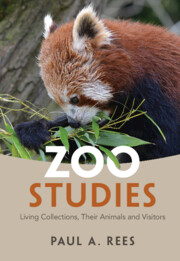
-
Select format
-
- Publisher:
- Cambridge University Press
- Publication date:
- 12 May 2023
- 01 June 2023
- ISBN:
- 9781108566049
- 9781108475068
- 9781108468725
- Dimensions:
- (244 x 170 mm)
- Weight & Pages:
- 1.06kg, 450 Pages
- Dimensions:
- (244 x 170 mm)
- Weight & Pages:
- 0.93kg, 450 Pages
- Subjects:
- Animal Behaviour, Life Sciences, Ecology and Conservation
You may already have access via personal or institutional login- Subjects:
- Animal Behaviour, Life Sciences, Ecology and Conservation
Book description
Zoos and aquariums are culturally and historically important places where families enjoy their leisure time and scientists study exotic animals. Many contain buildings of great architectural merit. Some people consider zoos little more than animal prisons, while others believe they play an important role in conservation and education. Zoos have been the subject of a vast number of academic studies, whose results are scattered throughout the literature. This interdisciplinary volume brings together research on animal behaviour, visitor studies, zoo history, human-animal relationships, veterinary medicine, welfare, education, enclosure design, reproduction, legislation, and zoo management conducted at around 200 institutions located throughout the world. The book is neither 'pro-' nor 'anti-' zoo and attempts to strike a balance between praising zoos for the good work they have done in the conservation of some species, while recognising that they face many challenges in making themselves relevant in the modern world.
Reviews
‘I would recommend this book to those interested in zoos/the work of zoos/animals in zoos, but predominantly as a book that introduces relevant topics/areas for consideration and offers direction for areas to further investigate, rather than as a sole provider of information on the complexities of modern zoos.’
Ellen Williams Source: Animal Welfare
Contents
Metrics
Altmetric attention score
Full text views
Full text views help Loading metrics...
Loading metrics...
* Views captured on Cambridge Core between #date#. This data will be updated every 24 hours.
Usage data cannot currently be displayed.
Accessibility standard: Unknown
Why this information is here
This section outlines the accessibility features of this content - including support for screen readers, full keyboard navigation and high-contrast display options. This may not be relevant for you.
Accessibility Information
Accessibility compliance for the PDF of this book is currently unknown and may be updated in the future.


